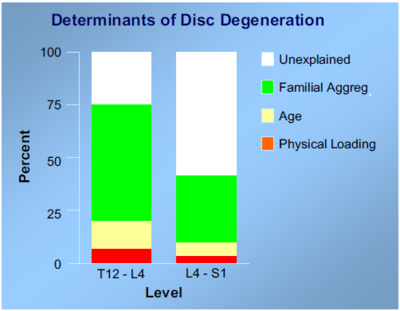EBQ:Twin Spine Study: Difference between revisions
No edit summary |
No edit summary |
||
| Line 1: | Line 1: | ||
Battié MC, Videman T, Kaprio J, Gibbons LE, Gill K, Manninen H, Saarela J, Peltonen L. The Twin Spine Study: contributions to a changing view of disc degeneration. Spine J. 2009 Jan-Feb;9(1):47-59. [https://doi.org/10.1016/j.spinee.2008.11.011 DOI]. [https://pubmed.ncbi.nlm.nih.gov/19111259/ PMID: 19111259]. [[:Media:Twin Spine Study - Battie 2009.pdf|Full Text]] | |||
==Clinical Question== | ==Clinical Question== | ||
Revision as of 16:50, 15 August 2021
Battié MC, Videman T, Kaprio J, Gibbons LE, Gill K, Manninen H, Saarela J, Peltonen L. The Twin Spine Study: contributions to a changing view of disc degeneration. Spine J. 2009 Jan-Feb;9(1):47-59. DOI. PMID: 19111259. Full Text
Clinical Question
What is the contribution of genetics to disc degeneration?
Bottom Line
There is a substantial influence of heredity on lumbar disc degeneration. There is little effect on disc degeneration from occupational and leisure-time physical loading, and increased loading may have a small benefit. There is only a small effect from smoking. Body weight and muscle strength have modest effects on disc degeneration. Some candidate genes were identified.
Study Design
The Twin Spine Study, which started in 1991, is a multidisciplinary, multinational research project with collaborators primarily in Canada, Finland, and the United States. They investigated occupational exposures, driving and whole-body vibration exposure, smoking exposure, anthropomorphic factors, heritability, and the identification of genotypes associated with disc degeneration.
Population Studied
Inclusion Criteria
Exclusion Criteria
Baseline Characteristics
Interventions
Outcomes/Results
Primary Outcomes
- T12–L4 region: 61% of the variance in disc degeneration was explained by familial aggregation, beyond that of age and occupational physical loading that together explained 16%.
- L4–S1 discs: 11% of disc degeneration was explained by physical loading and age, which rose to 43% once familial aggregation was added to the model. In contrast to the upper lumbar levels, 57% remained unexplained in the lower lumbar region


